Reverse sneezing, also known as paroxysmal respiration, is a common condition in dogs where they rapidly pull air in through the nose, producing a loud snorting sound. While it may be alarming to witness, it is usually harmless and often occurs in small dogs. The cause of reverse sneezing is believed to be inflammation or irritation of the nasal, pharyngeal, or sinus passages, and it can be triggered by various irritants such as dust, pollen, nasal mites, or an elongated soft palate. Most dogs experience reverse sneezing episodes for less than a minute and return to normal activities afterward. However, it is always a good idea to have your dog examined by a veterinarian if they develop sudden reverse sneezing or display other symptoms such as labored breathing, coughing, wheezing, or lethargy.
Key Takeaways:
- Reverse sneezing is a common and usually harmless condition in dogs where they rapidly inhale through the nose, producing a snorting sound.
- It is believed to be triggered by inflammation or irritation of the nasal, pharyngeal, or sinus passages.
- Reverse sneezing can be caused by various irritants such as dust, pollen, nasal mites, or an elongated soft palate.
- Most dogs experience reverse sneezing episodes for less than a minute and return to normal activities afterward.
- If your dog develops sudden reverse sneezing or displays other concerning symptoms, it is recommended to have them examined by a veterinarian.
What Is a Reverse Sneeze in Dogs?
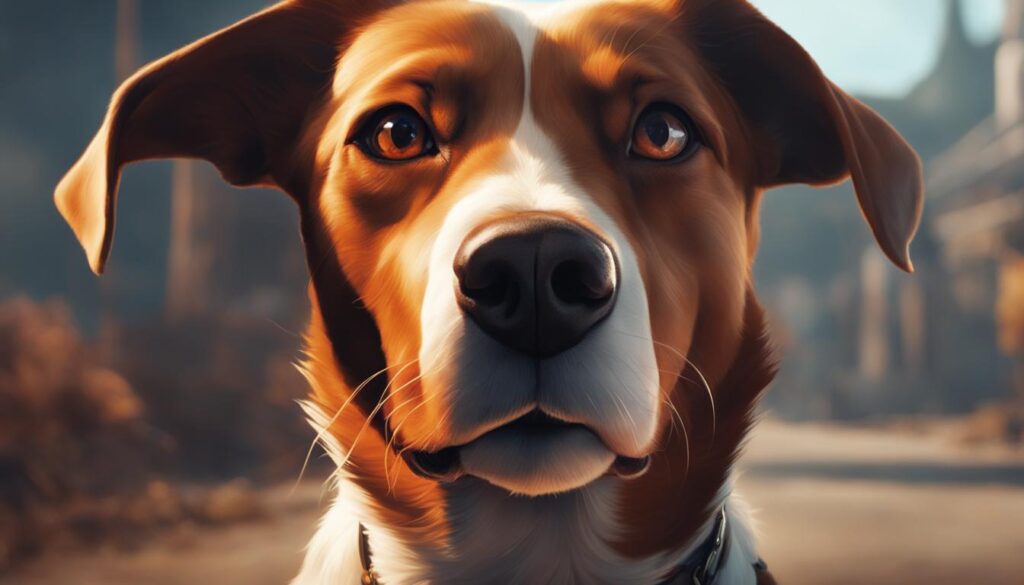
Reverse sneezing, medically known as paroxysmal respiration, is a condition in dogs where they rapidly pull air in through the nose, creating a snorting noise. It can be likened to a dog trying to take a deep breath while sneezing simultaneously. During a reverse sneezing episode, dogs typically raise their head, extend their neck, and make loud snorting sounds. This can be alarming for pet parents, but it is generally not a cause for concern. Most reverse sneezing episodes last less than a minute and dogs resume their normal activities afterward.
Reverse sneezing can be a peculiar behavior for dog owners to witness. It’s important to understand this respiratory phenomenon and its impact on our furry companions.
When a dog experiences a reverse sneezing episode, they quickly inhale air through their nose, creating a distinct snorting sound. It may seem as if the dog is trying to take a deep breath while sneezing simultaneously. During these episodes, dogs often raise their heads, extend their necks, and make loud snorting noises.
Characteristics of Reverse Sneezing in Dogs
Reverse sneezing episodes usually last for a brief period, typically less than a minute, and do not cause any lasting harm or discomfort to the dog. Once the episode is over, dogs quickly return to their normal activities.
Reverse sneezing is not a cause for immediate concern, but understanding this behavior can reassure pet owners and prevent unnecessary worry.
While reverse sneezing may sound concerning, it is generally a harmless and temporary respiratory issue that many dogs experience from time to time. The exact cause of reverse sneezing is not fully understood, but it is believed to be triggered by irritation or inflammation of the nasal, pharyngeal, or sinus passages.
What Triggers Reverse Sneezing in Dogs?
Reverse sneezing can be triggered by a variety of factors, including:
- Irritants such as dust, pollen, or smoke
- Nasal mites
- An elongated soft palate
- Allergies
These triggers can cause the nasal passages or back of the throat to become irritated, leading to a reverse sneezing episode in dogs.
Next, we will explore the various causes of reverse sneezing in dogs and how it can be diagnosed.
| Causes of Reverse Sneezing | Details |
|---|---|
| Allergies | Exposure to allergens such as pollen, dust, or mold spores can irritate the nasal passages and trigger reverse sneezing. |
| Nasal Mites | Infestation by microscopic nasal mites can cause irritation and inflammation, leading to reverse sneezing in dogs. |
| Anatomical Factors | An elongated soft palate or other structural abnormalities in the respiratory system can contribute to episodes of reverse sneezing. |
| Excitement or Overstimulation | Dogs may experience reverse sneezing when they become overly excited or stimulated. |
Causes of Reverse Sneezing in Dogs
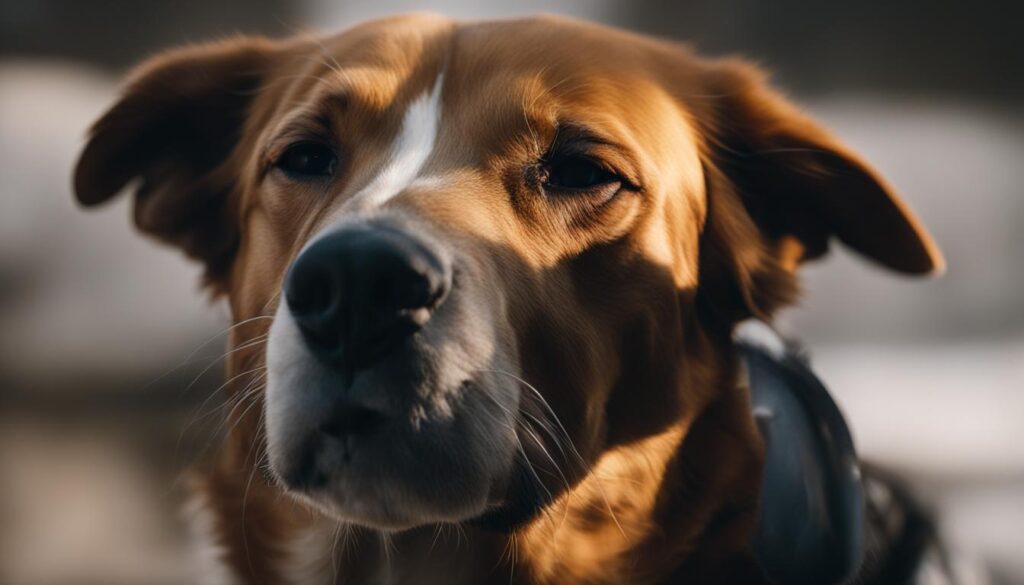
The exact cause of reverse sneezing in dogs is not fully understood. It is believed to be triggered by inflammation or irritation of the nasal, pharyngeal, or sinus passages. Some common irritants that can cause reverse sneezing include dust, pollen, nasal mites, seeds, grass, and even smoke. In some cases, dogs may also experience reverse sneezing when they are over-excited. It is important to note that reverse sneezing is usually not harmful to dogs and is often a natural reflex to clear the irritant from their system.
Common Causes of Reverse Sneezing in Dogs:
- Dust
- Pollen
- Nasal mites
- Seeds
- Grass
- Smoke
- Over-excitement
Understanding Reverse Sneezing:
“Reverse sneezing is a natural reflex in dogs that helps to clear irritants from their system. It is usually triggered by inflammation or irritation of the nasal, pharyngeal, or sinus passages. While it may sound alarming, it is generally harmless and dogs typically recover quickly.”
During a reverse sneezing episode, dogs may exhibit the following signs:
- Rapidly pulling air in through the nose
- Snorting or honking sounds
- Head extended upward
- Neck extended
These episodes typically last for less than a minute and dogs generally resume their normal activities afterward. However, if your dog experiences frequent or prolonged episodes of reverse sneezing, it is advisable to consult with a veterinarian to ensure there are no underlying health concerns.
Is Reverse Sneezing Harmful for Dogs?
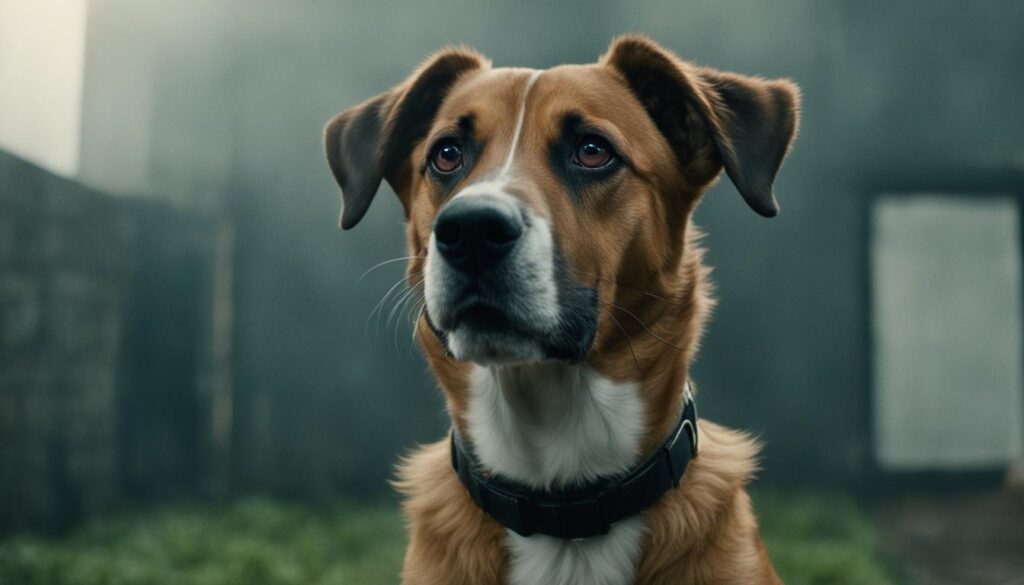
Reverse sneezing is a common respiratory issue in dogs that can be alarming for pet owners. However, in most cases, it is a harmless condition that resolves on its own. Reverse sneezing episodes typically last for less than a minute and dogs are able to resume their normal activities afterward.
While reverse sneezing itself is usually not harmful, it is important to monitor your dog for any additional symptoms that may indicate an underlying health problem. If your dog experiences labored breathing, an ongoing or consistent cough, frequent wheezing, panting without exercise, open-mouthed breathing, lethargy, lack of interest in exercise, or pale or blue gums, it is recommended to seek veterinary attention.
These symptoms may be associated with more serious conditions such as asthma, heart disease, or tracheal collapse. A veterinarian will be able to provide a proper diagnosis and recommend appropriate treatment if necessary.
It’s important to remember that every dog is different, and while most dogs experience reverse sneezing without any issues, some may require medical intervention. Always consult with a veterinarian if you have any concerns about your dog’s health.
Common Symptoms Associated with Reverse Sneezing
| Symptom | Possible Associated Conditions |
|---|---|
| Labored Breathing | Asthma, heart disease, tracheal collapse |
| Ongoing or Consistent Cough | Respiratory infection, kennel cough, collapsing trachea |
| Frequent Wheezing | Asthma, bronchitis, allergies |
| Panting Without Exercise | Respiratory distress, cardiovascular issues |
| Open-Mouthed Breathing | Respiratory distress, brachycephalic syndrome |
| Lethargy | Anemia, heart disease, respiratory infection |
| Lack of Interest in Exercise | Heart disease, respiratory disease |
| Pale or Blue Gums | Cardiovascular issues, oxygen deprivation |
How to Help Dogs Through a Reverse Sneezing Episode
If your dog experiences a reverse sneezing episode, there are a few things you can do to help ease their discomfort:
- Stay calm and upbeat to reduce your dog’s anxiety and stress during the episode.
- Address any anxiety or fear your pet may be facing by keeping them focused on enrichment toys and activities to avoid anxiety or overexcitement.
- Gently massage your dog’s throat to help stop the episode.
- Lift their head up and then gently lower it, which can also be effective in stopping the episode.
- Distract your dog with a toy, treat, or their dinner to divert their attention from the episode.
If your dog’s reverse sneezing episodes become frequent or severe, it is recommended to consult with a veterinarian for further evaluation and potential treatment options.
Remember to stay calm and provide comfort to your furry friend during a reverse sneezing episode. Your soothing presence and gentle actions can make a big difference in helping your dog through this temporary discomfort.
What Is Reverse Sneeze in Dogs – Understanding the Condition
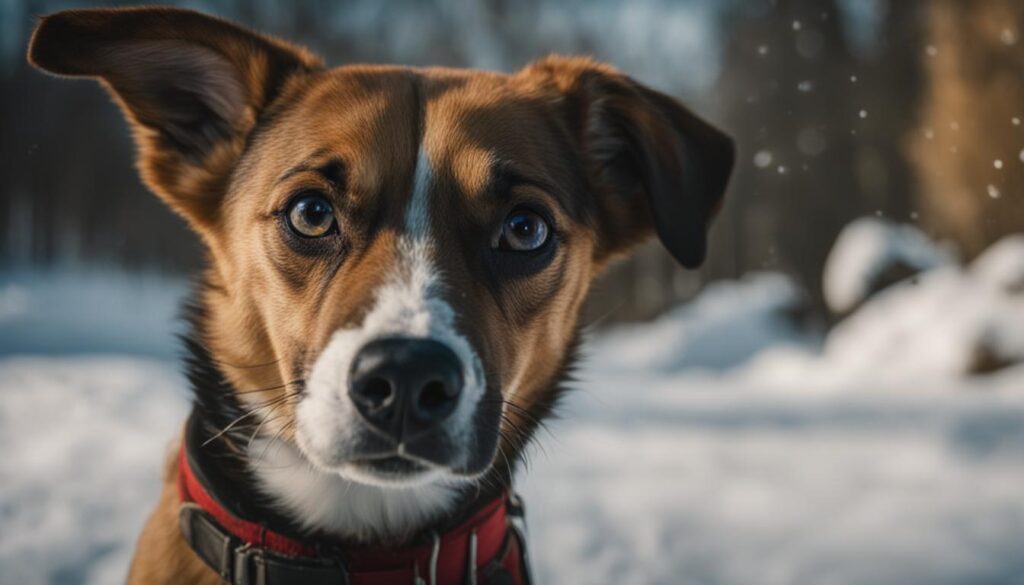
Reverse sneezing, also known as paroxysmal respiration, is a condition in dogs where they rapidly inhale through the nose, producing a snorting sound. This can be mistaken for a regular sneeze, but the mechanism is different. During a reverse sneezing episode, dogs typically stand still, extend their head and neck, and make rapid and long inspirations. The sound produced during a reverse sneezing episode can be loud and may resemble a dog having something caught in their nose or throat. These episodes usually last for several seconds to a minute.
The exact cause of reverse sneezing is unknown, but it is believed to be triggered by irritation to the nose, sinuses, or back of the throat. Nasal mites, secretions, foreign bodies, allergies, and an elongated soft palate are some potential irritants that can trigger reverse sneezing in dogs.
In some cases, reverse sneezing can be a natural reflex to clear irritants from a dog’s system. However, if your dog experiences frequent or severe reverse sneezing episodes, it is recommended to consult with a veterinarian for further evaluation and potential treatment options.
Diagnosing Reverse Sneezing in Dogs
The diagnosis of reverse sneezing in dogs is based on a thorough examination of the dog’s medical history and careful observation of clinical signs. When a dog presents with symptoms of reverse sneezing, a veterinarian will perform a comprehensive evaluation to rule out other possible causes of abnormal breathing and snorting.
During the diagnostic process, the veterinarian will assess the dog for any signs of an upper respiratory tract infection, collapsing trachea, nasal tumors or polyps, or foreign bodies in the nasal passages or mouth. These conditions can mimic reverse sneezing and must be excluded to reach an accurate diagnosis.
Additional diagnostic procedures may be performed in certain cases to further explore potential underlying conditions. Blood tests, allergy tests, or radiographs (X-rays) may be recommended to rule out other respiratory issues that can manifest with similar symptoms. These tests help ensure the diagnosis of reverse sneezing by excluding other possible causes.
The diagnosis of reverse sneezing is typically made based on the exclusion of other underlying conditions that could account for the dog’s respiratory distress and snorting behavior.
Treating Reverse Sneezing in Dogs
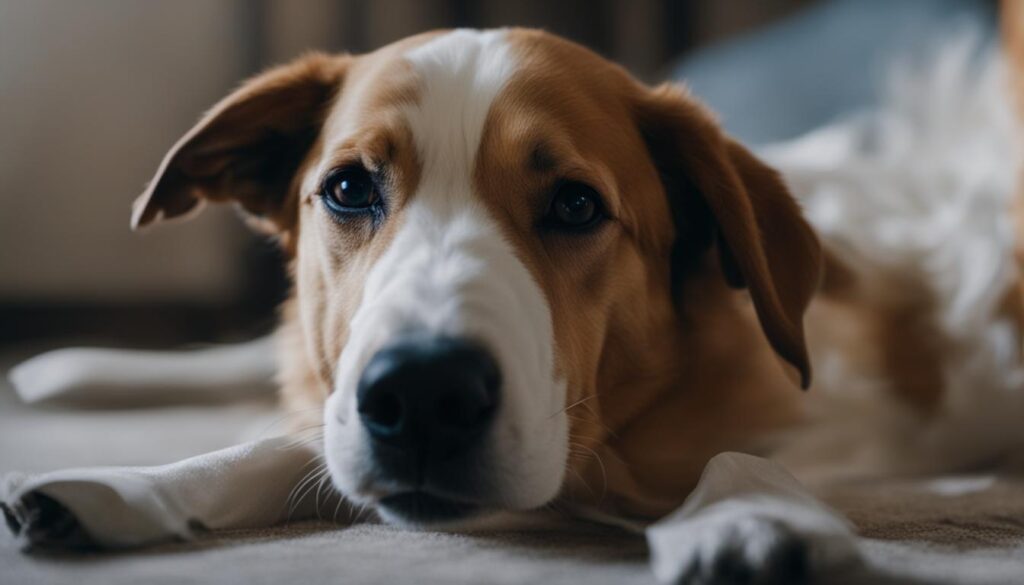
Most cases of reverse sneezing in dogs do not require medical treatment. If your dog experiences a reverse sneezing episode, there are a few simple measures you can take to provide relief and comfort.
Gentle Strokes and Nostril Covering
During a reverse sneezing episode, gently stroking your dog’s neck can help soothe them and alleviate their discomfort. Another technique you can try is covering their nostrils for a few seconds to prompt swallowing, which may help clear out any potential irritant.
Natural Resolution
It is essential to remember that most reverse sneezing episodes resolve on their own without any complications. These episodes typically last for a short duration, usually less than a minute, and dogs resume their normal activities afterward.
Medication Options
In certain cases where allergies play a significant role in triggering reverse sneezing, a veterinarian may prescribe anti-inflammatory, antihistamine, or decongestant medications to help manage the condition. While not commonly prescribed for reverse sneezing, these medications may be considered as a treatment option.
Treatment Options for Reverse Sneezing in Dogs: Comparative Analysis
| Treatment Option | Benefits | Considerations |
|---|---|---|
| 1. Gentle Strokes and Nostril Covering | – Provides immediate relief and comfort – Can be easily done at home |
– May not be effective for all dogs – Requires gentle and cautious handling |
| 2. Natural Resolution | – Most episodes resolve on their own – No potential side effects |
– Can cause momentary distress to the dog and pet parent – Episodes may recur |
| 3. Medication Options | – Can help manage reverse sneezing triggered by allergies – Potential reduction in frequency and severity of episodes |
– Requires veterinary consultation and prescription – Possible side effects |
It is important to consult with a veterinarian if your dog frequently experiences reverse sneezing episodes or if the episodes become severe, as further evaluation and treatment may be necessary to address any underlying causes.
Living with Reverse Sneezing in Dogs

If your dog has been diagnosed with reverse sneezing, it is important to understand that it may be a recurring condition. While reverse sneezing itself is not serious, it is still recommended to have your dog checked by a veterinarian to rule out any underlying health conditions.
If no severe conditions are found, you can simply monitor your dog during reverse sneezing episodes and provide them with comfort and reassurance. Gentle petting can help soothe your dog, but avoid petting their face or snout to allow them to continue the sneezing episode. Most dogs do not require medication or ongoing medical intervention for reverse sneezing, but if the episodes are frequent or severe, consult with your veterinarian for appropriate management options.
| Living with Reverse Sneezing in Dogs | |
|---|---|
| • Monitor your dog during reverse sneezing episodes | • Provide comfort and reassurance |
| • Gentle petting can help soothe your dog | • Avoid petting their face or snout |
| • Most dogs do not require medication for reverse sneezing | • Seek veterinary advice for frequent or severe episodes |
Wrapping Up
Reverse sneezing is a common and usually harmless condition in dogs. It occurs when dogs rapidly pull air in through their nose, resulting in a snorting sound. While witnessing a reverse sneezing episode can be alarming, it is important to remember that most dogs experience short episodes and quickly return to their normal activities without any health complications.
However, it is crucial to monitor your dog for any additional symptoms that may indicate an underlying respiratory issue. If your dog exhibits signs of labored breathing, a persistent cough, or pale gums, it is advised to seek veterinary attention. These symptoms could be indicative of a more serious condition that requires medical intervention.
Understanding reverse sneezing and knowing how to assist your dog during an episode can help alleviate any concerns and provide comfort to your furry companion. Remember to stay calm and offer reassurance to your dog. Gently stroking their neck, elevating their head, or providing a distraction, such as a toy or treat, may help alleviate the episode. If reverse sneezing episodes become frequent or severe, consulting with a veterinarian can provide further guidance on managing the condition.
FAQ
What is reverse sneezing in dogs?
Reverse sneezing, also known as paroxysmal respiration, is a common condition in dogs where they rapidly pull air in through the nose, producing a loud snorting sound. It is often harmless and typically occurs in small dogs.
What causes reverse sneezing in dogs?
The exact cause of reverse sneezing in dogs is not fully understood, but it is believed to be triggered by inflammation or irritation of the nasal, pharyngeal, or sinus passages. Common irritants include dust, pollen, nasal mites, or an elongated soft palate.
Is reverse sneezing harmful for dogs?
Reverse sneezing is usually harmless for most dogs. The episodes are brief and dogs resume their normal activities afterward. However, it is important to monitor for additional symptoms that may indicate an underlying health problem.
How can I help my dog through a reverse sneezing episode?
During a reverse sneezing episode, you can stay calm and soothe your dog. Gently massaging their throat or lifting their head can help stop the episode. Distractions such as toys, treats, or dinner can also divert their attention.
How is reverse sneezing diagnosed in dogs?
The diagnosis of reverse sneezing in dogs is based on medical history and clinical signs. A veterinarian may rule out other possible causes through physical examinations and tests.
Is treatment necessary for reverse sneezing in dogs?
Most cases of reverse sneezing in dogs do not require medical treatment. However, if the episodes are frequent or severe, a veterinarian may prescribe medications such as anti-inflammatories, antihistamines, or decongestants.
Can I live with a dog that has reverse sneezing?
Yes, most dogs with reverse sneezing can live normal lives without any major complications. It is important to monitor their episodes and provide comfort during episodes.
What is the conclusion about reverse sneezing in dogs?
Reverse sneezing is a common and generally harmless condition in dogs. Understanding the causes, recognizing the symptoms, and knowing how to help your dog through an episode can provide comfort and reassurance.






